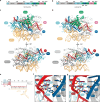Cas12e orthologs evolve variable structural elements to facilitate dsDNA cleavage
- PMID: 39737904
- PMCID: PMC11685505
- DOI: 10.1038/s41467-024-54491-9
Cas12e orthologs evolve variable structural elements to facilitate dsDNA cleavage
Abstract
Exceptionally diverse type V CRISPR-Cas systems provide numerous RNA-guided nucleases as powerful tools for DNA manipulation. Two known Cas12e nucleases, DpbCas12e and PlmCas12e, are both effective in genome editing. However, many differences exist in their in vitro dsDNA cleavage activities, reflecting the diversity in Cas12e's enzymatic properties. To comprehensively understand the Cas12e family, we identify and characterize six unreported Cas12e members that vary in their CRISPR-locus architectures, PAM preferences, and cleavage efficacies. Interestingly, among all variants, PlmCas12e exhibits the most robust trans-cleavage activity and the lowest salt sensitivity in cis-cleavage. Further structural comparisons reveal that the unique NTSB domain in PlmCas12e is beneficial to DNA unwinding at high salt concentrations, while some NTSB-lacking Cas12e proteins rely on positively charged loops for dsDNA unwinding. These findings demonstrate how divergent evolution of structural elements shapes the nuclease diversity within the Cas12e family, potentially contributing to their adaptations to varying environmental conditions.
© 2024. The Author(s).
Conflict of interest statement
Competing interests: J.J.G.L., S.Z., and D.L. have submitted patent applications to the China patent office pertaining to the following aspects of this work: (1) DNA manipulating tools using CRISPR-LesCas12e, -VemCas12e, -HrbCas12e, and -CkbCas12e systems. Applicant: Tsinghua University. Status: Granted. Application number: 2022106204929 [P]. (2) DNA manipulating tools using CRISPR-OpbCas12e and -Plm2Cas12e systems. Applicant: Tsinghua University. Status: Filed. The remaining authors declare no competing interests.
Figures






Similar articles
-
PlmCas12e Utilizes Glu662 to Prevent Cleavage Site Occupation by Positively Charged Residues Before Target Strand Cleavage.Molecules. 2024 Oct 25;29(21):5036. doi: 10.3390/molecules29215036. Molecules. 2024. PMID: 39519677 Free PMC article.
-
Position of Deltaproteobacteria Cas12e nuclease cleavage sites depends on spacer length of guide RNA.RNA Biol. 2020 Oct;17(10):1472-1479. doi: 10.1080/15476286.2020.1777378. Epub 2020 Jun 21. RNA Biol. 2020. PMID: 32564655 Free PMC article.
-
TracrRNA reprogramming enables direct PAM-independent detection of RNA with diverse DNA-targeting Cas12 nucleases.Nat Commun. 2024 Jul 13;15(1):5909. doi: 10.1038/s41467-024-50243-x. Nat Commun. 2024. PMID: 39003282 Free PMC article.
-
Editor's cut: DNA cleavage by CRISPR RNA-guided nucleases Cas9 and Cas12a.Biochem Soc Trans. 2020 Feb 28;48(1):207-219. doi: 10.1042/BST20190563. Biochem Soc Trans. 2020. PMID: 31872209 Free PMC article. Review.
-
Anti-CRISPRs: Protein Inhibitors of CRISPR-Cas Systems.Annu Rev Biochem. 2020 Jun 20;89:309-332. doi: 10.1146/annurev-biochem-011420-111224. Epub 2020 Mar 18. Annu Rev Biochem. 2020. PMID: 32186918 Free PMC article. Review.
Cited by
-
ENHANCED CLEAVAGE OF GENOMIC CCR5 USING CASX2Max.bioRxiv [Preprint]. 2025 Jul 11:2025.07.08.663680. doi: 10.1101/2025.07.08.663680. bioRxiv. 2025. PMID: 40672203 Free PMC article. Preprint.
-
CRISPR/Cas-Based Ex Vivo Gene Therapy and Lysosomal Storage Disorders: A Perspective Beyond Cas9.Cells. 2025 Jul 25;14(15):1147. doi: 10.3390/cells14151147. Cells. 2025. PMID: 40801580 Free PMC article. Review.
-
CRISPR/Cas9: a sustainable technology to enhance climate resilience in major Staple Crops.Front Genome Ed. 2025 Mar 18;7:1533197. doi: 10.3389/fgeed.2025.1533197. eCollection 2025. Front Genome Ed. 2025. PMID: 40171546 Free PMC article. Review.
References
Publication types
MeSH terms
Substances
Associated data
- Actions
- Actions
- BioProject/PRJNA1172643
Grants and funding
- 32150018/National Natural Science Foundation of China (National Science Foundation of China)
- 21877069/National Natural Science Foundation of China (National Science Foundation of China)
- 22277063/National Natural Science Foundation of China (National Science Foundation of China)
- 22061160466/National Natural Science Foundation of China (National Science Foundation of China)
- 32101195/National Natural Science Foundation of China (National Science Foundation of China)
LinkOut - more resources
Full Text Sources
Other Literature Sources
Miscellaneous

